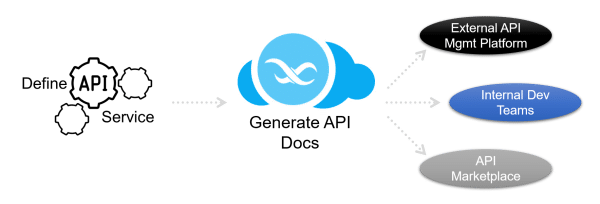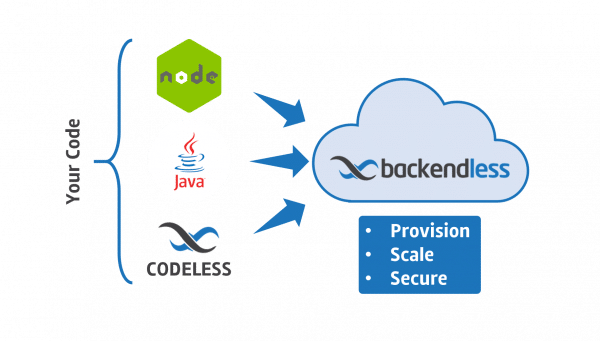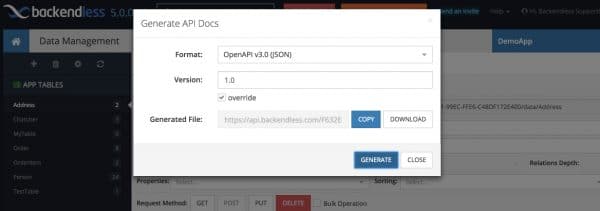What Is API As A Service?

API services are a means for an application to interact with a server-side system to retrieve and/or update data. API as a Service, then, is a platform or tool that offers support for designing and deploying API services.
In order to discuss what API as a Service is, we must first understand what APIs and API Services (and microservices) are. In this article, we are going to explain these terms in the simplest form possible so that you can better understand how APIs fit into your business needs.
API services are the lifeblood of most mobile applications. In order to save space on the user’s device, modern applications will store much of their logic and data on a server or in the cloud. By doing this, the client application (the user’s phone, for instance) requires much less storage space.
As a result, however, the client device must be connected to the internet to function. This is because APIs, described in more detail below, are used to send and receive information from the server, aka the backend.
APIs are used by most applications to achieve certain common tasks. These include user registration and login, database access and data modification/storage, file access and storage, and client-to-client messaging.
These basic APIs are critical to the success of any app. A platform or service that offers backend services but does not offer these kinds of APIs standard can be very cumbersome to work with.
Alternatively, a platform that does offer them, like Backendless, can speed up development time dramatically.
This article is part of our FAQ series that answers basic questions related to mobile backend as a service (MBaaS). Other articles include: “What is Serverless Computing?” and “What is Mobile Backend as a Service (MBaaS)?”
Table of Contents
- What is an API (or API Service)?
- API Services vs. API Microservices
- What is API as a Service (AaaS)?
- What are RESTful APIs?
- How to use Backendless as API as a Service
- Conclusion
What Is An API (or API Service)?
API (Application Programming Interface) services are interfaces that provide a program with a description of how to interact with a system in order to retrieve and/or change the data within it.
For the purpose of this article, an API Service is the means with which a piece of software (say, a mobile app) interacts with the functionality stored in the software’s backend (i.e. on the server or made available by a third party).
Although there are some technical differences, for this article, we will assume that the APIs we discuss are “web APIs”; that is, APIs provided over the HTTP/HTTPS protocol.
For example, consider perhaps the most common API service: user authentication. Whenever you register an account with an online service or mobile app, your registration is authenticated. This authentication may occur through the service provider themselves or via a third party using OAuth.
User authentication is virtually always processed via API. This is because the process requires the user’s information to be validated against, then stored in, a database.
It would not make sense, nor perhaps even be possible, to register using only the client-side interface. User registration information must be validated and stored on the backend in order for the user to be granted access to protected or personalized content on the frontend.
Some applications take advantage of client-side storage to offer “offline modes”. In effect, these applications store data in the device’s memory until the device reconnects to the internet and can submit the stored data via API.
API Services vs. API Microservices
The term API microservice describes an API that interacts with a backend that uses the architectural structure known as microservices. Microservice architecture is a method for building applications in which components are broken down into small, independent pieces. The alternative is containing all components in a single, siloed (or monolithic) application.
 Microservices are contained in small, individual containers rather than being included in a single, large application. The advantage of this approach is that it allows for much safer modification of backend code.
Microservices are contained in small, individual containers rather than being included in a single, large application. The advantage of this approach is that it allows for much safer modification of backend code.
This is because you are simply changing one element rather than having to modify and redeploy the entire application. Subsequently, this makes debugging much easier because you can quickly see which element is causing issues.
Another benefit of the microservice approach is that the self-contained elements are highly reusable. This plays a key role in what we will discuss next.
What is API as a Service?
In a recent article by TechCrunch, the well-known tech blog site described APIs as the next big wave in Software as a Service (SaaS). API as a Service is, in essence, a software platform that allows users to interact with third-party APIs as well as manage their own custom APIs.
An API as a Service platform provides two key elements:
- The ability to build, test, and deploy one’s own API services, and
- The ability to connect an application with third-party APIs.
Third-party APIs come in many forms. In addition to the aforementioned authentication example, an application may access third-party APIs such as Google Maps, payment processing services, and voice search APIs.
Another critical element of API as a Service: the ability to generate API docs. API documentation is necessary to describe the purpose, functionality, and inputs required for each API. Documentation allows APIs to be shared seamlessly among teams within an organization, or to be made available to others as third-party APIs.
 What are RESTful APIs?
What are RESTful APIs?
The most common architectural style for modern web services is called REST (representational state transfer). REST APIs use a stateless protocol and standard operations in order to achieve fast performance, reliability, and growth through the reuse of components.
Much like microservices, REST APIs aim to use primarily reusable components that can easily be interchanged, modified, and updated without affecting the system as a whole. This provides protection when developing and updating your application by reducing the risk of breaking something system-wide.
An application is said to be RESTful when it is composed mostly or entirely of REST APIs. REST APIs may be used individually within an application, or they may be contained within an SDK (software development kit).
How to use Backendless as API as a Service
As a full-service application development platform, Backendless is a fully-capable API as a Service platform. Backendless is built using the microservice architecture. This means that all of Backendless’ built-in APIs can be used individually or in tandem within an application. All Backendless APIs are available as basic REST APIs and for all of our SDKs, including iOS, Android, and Flutter.
Similar to the built-in APIs, Backendless allows you to create your own with Java, JavaScript or Codeless. Backendless automatically generates the API endpoints by inspecting the code you deploy. Alternatively, if you build APIs on another platform, you can easily import them into a Backendless backend.
The Backendless Platform provides many tools for API Management. You can build APIs in our platform using the Codeless builder, or write Java or JavaScript/Node.js code and convert it into an API instantly. With CodeRunner, you can develop and debug APIs on your local computer and then instantly deploy to the cloud when ready.
 Additionally, we give you the ability to import your APIs from a variety of sources. Once they are in our platform, you can easily modify, combine, or create new APIs right from your browser, continuous integration system, or developer workstations.
Additionally, we give you the ability to import your APIs from a variety of sources. Once they are in our platform, you can easily modify, combine, or create new APIs right from your browser, continuous integration system, or developer workstations.
API Documentation
Backendless provides thorough documentation for all of our built-in APIs. We also have built automatic API doc generation into the Backendless Console. That way, your developers can easily document and share APIs.
We are developing an API Marketplace that will make it possible for your development team to share APIs with other Backendless users. Right now, you can share APIs on the marketplace for your other teams to access. In the future, you will also have the ability to generate additional revenue by licensing your APIs to third parties via the marketplace.
You can learn more about Backendless’ API Service capabilities on our Features page.
Conclusion
In this article, we define API, API services, RESTful APIs, and explained their value. We also discussed the concept of API as a Service and evaluated how Backendless can be viewed as such a platform.
We hope that this provided some clarity about what APIs do as well as the meaning of API as a Service. If you’d like to try Backendless as your API management platform, you can start for free with Backendless Cloud here. For more advanced users, you can install Backendless Pro on your own machine for a free trial.

